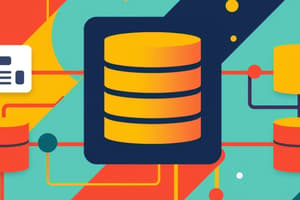Podcast
Questions and Answers
In the context of databases, what distinguishes 'information' from 'data'?
In the context of databases, what distinguishes 'information' from 'data'?
- Data is processed to give it context and meaning, whereas information is raw and unorganized. (correct)
- Data represents relationships between different entities, while information is isolated facts.
- Information is always numerical, while data can be textual or numerical.
- Information is stored in databases, while data is stored in spreadsheets.
Which of the following is not a typical phase in information processing?
Which of the following is not a typical phase in information processing?
- Data output/presentation
- Data validation (correct)
- Data storage
- Data capture
What is a primary expectation of a Database Management System (DBMS)?
What is a primary expectation of a Database Management System (DBMS)?
- To allow for the creation of database structures and query data using appropriate languages. (correct)
- To automatically generate reports without user input.
- To provide a user interface that is identical across all operating systems.
- To convert existing data into a format compatible with any software.
Which of the following is most closely associated with describing the structure or schema of data within a database?
Which of the following is most closely associated with describing the structure or schema of data within a database?
How do database systems address the limitations of manual and computerized file systems?
How do database systems address the limitations of manual and computerized file systems?
In a database context, what does a 'tuple' represent?
In a database context, what does a 'tuple' represent?
Which of the following correctly orders the units of data storage from smallest to largest?
Which of the following correctly orders the units of data storage from smallest to largest?
Which of the following is an example of a Database Management System (DBMS)?
Which of the following is an example of a Database Management System (DBMS)?
What role does the 'query compiler' play within a Database Management System (DBMS) architecture?
What role does the 'query compiler' play within a Database Management System (DBMS) architecture?
Which of the following is a primary advantage of using a database system compared to traditional file systems?
Which of the following is a primary advantage of using a database system compared to traditional file systems?
What is the purpose of creating a Conceptual Entity Relationship Model (ERM) in database design?
What is the purpose of creating a Conceptual Entity Relationship Model (ERM) in database design?
Which of the following database system studies involves the translation of data requirements into database tables?
Which of the following database system studies involves the translation of data requirements into database tables?
What is the role of “logging recovery” in a Database Management System (DBMS)?
What is the role of “logging recovery” in a Database Management System (DBMS)?
Which of the following reflects manual and computerised files?
Which of the following reflects manual and computerised files?
Which of the following is a concept associated with a database?
Which of the following is a concept associated with a database?
Which of the following is considered a disadvantage of database systems?
Which of the following is considered a disadvantage of database systems?
In evolution of database systems, what does collection of information existing over a long period of time mean?
In evolution of database systems, what does collection of information existing over a long period of time mean?
What does the 'execution engine' do within the DBMS?
What does the 'execution engine' do within the DBMS?
Why is data a corporate asset?
Why is data a corporate asset?
What does Normalisation do during database design?
What does Normalisation do during database design?
Flashcards
What is Data?
What is Data?
Raw facts, events, and transactions that are of concern in a business.
What is Information?
What is Information?
Data that has been processed to be useful and provide context.
What a DBMS is expected to do?
What a DBMS is expected to do?
Allow creation of database structures. Enable querying and data recovery. Control access and ensure security.
Examples of Data
Examples of Data
Signup and view all the flashcards
What is Information?
What is Information?
Signup and view all the flashcards
Database System Terms
Database System Terms
Signup and view all the flashcards
What is a Database?
What is a Database?
Signup and view all the flashcards
Examples of Database Systems
Examples of Database Systems
Signup and view all the flashcards
Advantages of Database Systems
Advantages of Database Systems
Signup and view all the flashcards
Disadvantages of Database Systems
Disadvantages of Database Systems
Signup and view all the flashcards
Basic steps in Database Design
Basic steps in Database Design
Signup and view all the flashcards
What is Information?
What is Information?
Signup and view all the flashcards
Phases of Information processing
Phases of Information processing
Signup and view all the flashcards
What is Increase in Size Requirements?
What is Increase in Size Requirements?
Signup and view all the flashcards
Study Notes
Data and Information
- Data includes dates, values, and names.
- For example: "21/04/1998", "Frank", "Luton", "Derby".
- Information is data given context, providing it with meaning.
- Information describes relationships between different pieces of data.
- For example: "Frank Derby was born in Luton on 21/04/1998".
Evolution of Database Systems
- Databases consist of information collected over time.
- Data and information are valuable assets for businesses.
- Data consists of raw facts, events, and transactions managed by a Database Management System (DBMS) in a business setting.
- Information is data that has been processed for use.
- Ted Codd developed the database for IBM in the 1970s.
- Codd won the Turing Award in 1981.
Information Process
- Information processing involves data capture, recording, and storage,
- Data processing consists of updating, deleting, and retrieval
- Data output and presentation.
Database Management System (DBMS) Expectations
- Enable database structure creation.
- Allow users to query data using appropriate languages.
- Support storage of large data amounts over long periods.
- Provide recovery from failures, errors, or misuse.
- Manage data access for multiple users with security measures.
Evolution and Terminologies Associated with Systems
- Manual and Computerised Systems use files, records, data items/fields, and cabinets.
- Database Systems use relations/tables, rows/tuples, columns/attributes, objects/entities, and relationships.
- UML Systems use classes/sub Classes, associations, attributes, methods, operations, and inheritance.
Systems Essential to Every Business
- Manual and Computerised Files considerations include their appearance, functionality, and limitations
- Database Systems are used daily and come with their own appearance, associated concepts, and functionality.
Example: Customer Table (or Relation)
- The customer table shows the "Cust_ID", "F_Name", "L_Name", and "DOB" attributes
- A record (or tuple) shows the information for one customer
Increase in Size Requirements
- DBMS in the 1970s were used for banking, airline reservation systems, and corporate record keeping.
- More recently, Google stores exabytes of web data using specialized structures for search engine queries.
- Satellites store petabytes of information in specialized systems.
- Pictures take up more storage space than words
- Videos use gigabytes of space, like on YouTube.
- 1 Exabyte equates to 1,000,000,000 GB.
Data Size
- Bit (b) is 0 or 1
- Byte (B) is 8 bits
- Kilobyte (KB) is 1000¹ bytes in decimal value and 1024¹ bytes in binary value
- Megabyte (MB) is 1000² bytes in decimal value and 1024² bytes in binary value
- Gigabyte (GB) is 1000³ bytes in decimal value and 1024³ bytes in binary value
- Terabyte (TB) is 1000⁴ bytes in decimal value and 1024⁴ bytes in binary value
- Petabyte (PB) is 1000⁵ bytes in decimal value and 1024⁵ bytes in binary value
- Exabyte (EB) is 1000⁶ bytes in decimal value and 1024⁶ bytes in binary value
- Zettabyte (ZB) is 1000⁷ bytes in decimal value and 1024⁷ bytes in binary value
- Yottabyte (YB) is 1000⁸ bytes in decimal value and 1024⁸ bytes in binary value
- A Nibble is 4 bits (not shown)
What Databases Look Like
- A database is a collection of related data, and DBMS is software that manages and controls access.
- Example DBMS programs: MS Access, Oracle SQL, MySQL, SQl Server, Foxpro, SQL Lite, MongoDBetc.
Database Management System Components
- Key components include user apps, query compiler, transaction manager, DDL compiler, execution engine, logging recovery, concurrency control, index/file/record, buffer manager, buffers, lock table, storage manager, and storage along with DB Admin duties
Pros and Cons of Database Systems
- Advantages include control of data redundancy, data consistency, more information from the same amount of data, data sharing, improved security, enforcement of standards, improved maintenance through data independence, and increased concurrency.
- Disadvantages include complexity, size, cost of DBMSs, additional hardware costs, cost of conversion, performance issues, and a higher impact of failure.
Database Design Steps
- Determine the database's purpose & its information requirements
- Analyse the system,
- Produce a Conceptual Entity Relationship Model,
- Normalise the database design.
- Convert the conceptual data model to a physical data model.
Database System Studies
- Areas of study include relational database modeling, relational database programming.
- Areas of study include web development and database systems implementation.
- Areas of study include modern database systems and search engines.
Summary
- Data is a valuable corporate asset.
- Data processing helps in making informed decisions
- Information processing involves distinct phases.
- You must be aware of manual file systems, computerised file systems and database systems
- Understanding database concepts and terminologies like data, information, record, field, file, and DBMS is important.
Studying That Suits You
Use AI to generate personalized quizzes and flashcards to suit your learning preferences.




